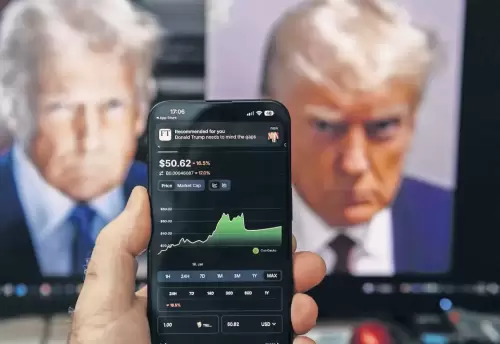 |
|
 |
|
 |
|
 |
|
 |
|
 |
|
 |
|
 |
|
 |
|
 |
|
 |
|
 |
|
 |
|
 |
|
 |
|
Cryptocurrency News Articles
Bitcoin Solaris Enters the Smart Contract Economy with Faster Transactions and Full User Access
May 09, 2025 at 07:00 pm
Ethereum shaped the early smart contract economy — but in 2025, it remains burdened by its own architecture. Despite years of upgrades, scalability limits and cost volatility persist.

Bitcoin Solaris is a new blockchain project that claims to offer an alternative to Ethereum with faster transaction speeds and full user access.
Where Ethereum is often heralded for spearheading the smart contract revolution, Bitcoin Solaris aims to take the technology mainstream with a design optimized for speed, inclusion, and mobile-first usability.
At a glance, here are some key advantages that Bitcoin Solaris offers over Ethereum:
● 10,000+ TPS vs 15–30 TPS
At its base layer, Ethereum can handle around 15–30 transactions per second (TPS). While protocols like Arbitrum and Optimism offer improvements under ideal conditions, they come with trade-offs. Users must bridge assets, navigate separate environments, and accept delayed finality for mainnet settlement.
Bitcoin Solaris operates differently. It combines a Helios Consensus Mechanism with a dual-layer architecture to achieve over 10,000 TPS and keeps confirmation times close to real-time.
● No High Gas Fees
Even simple ETH transfers can cost several dollars during peak times, and more complex DeFi interactions may rise significantly higher. This pricing actively discourages everyday, low-value usage.
Bitcoin Solaris's gas fees are significantly lower and designed to remain stable over time.
● Everyone Can Mine
To become a validator on Ethereum, users need to commit 32 ETH and maintain the technical infrastructure. This barrier has been lowered somewhat by delegation platforms, but real influence remains concentrated in larger pools.
Bitcoin Solaris offers a more equal opportunity. Its Nova App enables any user to mine tokens directly on their smartphone. No hardware, no validator setup, just a portion of device storage and CPU idle time is allocated for mining.
This difference is crucial. It opens up participation to average users who may not have thousands of dollars to invest in crypto or the technical background to self-install and maintain a validator node.
The Bitcoin Solaris Network
The Bitcoin Solaris ecosystem is designed around three core pillars:
1. Helios Consensus
The Helios Consensus Mechanism is a hybrid protocol that combines elements of Proof-of-Work, Proof-of-Stake, and a unique time-based chain to optimize for both speed and decentralization.
It’s capable of achieving over 10,000 TPS while maintaining a decentralized structure with no single point of failure.
2. Nova App
The Nova App is a mobile application that allows users to contribute to the Bitcoin Solaris network and earn mining rewards directly on their smartphones.
It’s currently in its final pre-launch phase and scheduled to go live soon. Once active, the app will offer:
• Real-time mining rewards
• Staking options
• Full wallet integration
3. BTC-S Token
Bitcoin Solaris follows a fixed-supply model with 21 million BTC-S tokens, mirroring Bitcoin’s capped scarcity. From this, 4.2 million tokens (20%) are allocated for public presale.
The project has completed Phase 1 of the presale with tokens priced at 1 USDT. Following a sellout, it’s now moved to Phase 2, where tokens are priced at 2 USDT each.
Tokens purchased during the presale are immediately liquid and will be usable within the Nova App and broader network environment upon launch. There are no vesting, lockup, or restricted tiers.
In addition, all smart contracts, consensus mechanics, and token systems have been audited and verified by third parties. There are no off-chain dependencies or validator whitelists. Every part of the system is visible and verifiable.
At a glance, here are the results of the audits:
• Solidity Finance
• ChainMagic
• Coinscope
The audits highlight that the smart contracts are designed in a secure manner and conform to best practices. They also highlight the absence of critical vulnerabilities or backdoors.
This level of scrutiny and the results of the audits speak to the project's commitment to transparency and building a sustainable ecosystem.
The Bottom Line
Bitcoin Solaris claims to be offering a blockchain network with faster transaction speeds and full user access compared to Ethereum. Through its dual-layer architecture and mobile-first design, the network can process over 10,000 transactions per second and enable everyday users to mine tokens directly from their smartphones.
Disclaimer:info@kdj.com
The information provided is not trading advice. kdj.com does not assume any responsibility for any investments made based on the information provided in this article. Cryptocurrencies are highly volatile and it is highly recommended that you invest with caution after thorough research!
If you believe that the content used on this website infringes your copyright, please contact us immediately (info@kdj.com) and we will delete it promptly.
-

-

-

-

- Trump's Campaign Disputed Allegations Friday That the President Is Using His Office for Personal Gain by Peddling a Cryptocurrency Meme Coin
- May 10, 2025 at 06:10 am
- The White House press secretary disputed allegations Friday that President Donald Trump is using his office for personal gain by peddling a cryptocurrency meme coin and visiting a
-

-

- If you've been watching crypto circles this May, you've likely noticed one meme coin flying higher than the rest, Dragoin ($DDGN).
- May 10, 2025 at 06:05 am
- With a dragon-fueled Telegram game, medieval-themed presale stages, and a real shot at 6,700% ROI, Dragoin has transformed from a niche fantasy concept into what many are calling the hottest meme coin to buy now.
-

-

-




























































